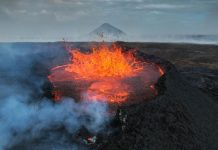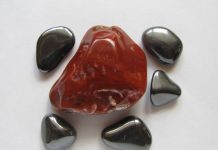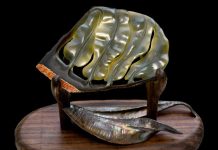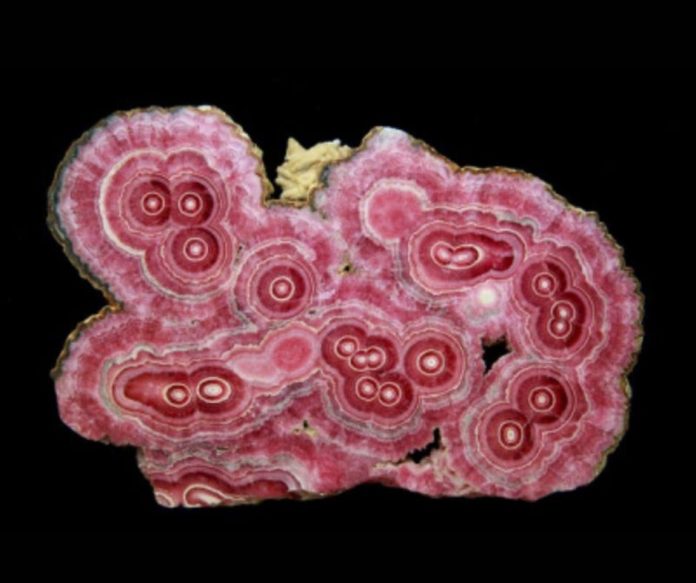
Rhodochrosite is a member of the calcite group of trigonal carbonate minerals. The variety of massive rhodochrosite called the “Inca rose” is translucent to opaque and adorned with delicate banding, its colors range from intense rose-red to every shade of pink. Most eye-catching are polished slabs of rare stalactitic Inca rose adorned with their signature patterns of colorful, surreal, concentric rings.
Red roses are a big part of the culture of Argentina. Since European immigrants introduced the flowers in the early 1800s, they have evolved into the beloved, however unofficial, national symbol of love, beauty and strength. The famed rose gardens of Buenos Aires are one of that capital city’s major attractions. Red roses also figure prominently in Argentinian art and festivals; they are even an economic factor as the nation’s third-largest export.
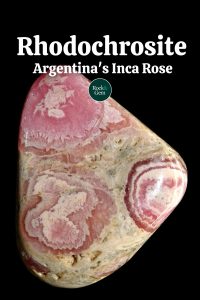
Manganese Carbonate
Rhodochrosite (manganese carbonate, MnCO3) has a Mohs Scale of Hardness of 3.5-4.5, a specific gravity of 3.5-3.6 and, like calcite, perfect, three-directional cleavage. When pure, rhodochrosite is a deep rose-red, a color that calcium and magnesium ions often lighten to pink and zinc ions alter to brownish-yellow.
Although known since antiquity, rhodochrosite was not scientifically described until 1813. Its name stems from the Greek words rhodon, meaning “rose” and chrōs, “color.”
Rhodochrosite is widely distributed, but uncommon. As a hydrothermal-vein mineral, it occurs primarily as a minor component of multimetal sulfide deposits, with one major exception—Argentina’s Capillitas Mining District.
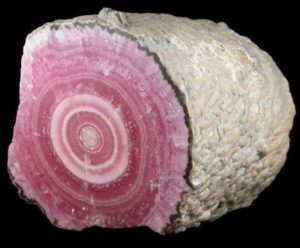
Argentina’s Rhodochrosite Bonanza
A remote, 10,000-foot-high mining district in the Andean foothills of northeast Argentina’s Catamarca Province, Capillitas is the sole source of Inca rose. This deposit formed seven million years ago when volcanics intruded Paleozoic granite and associated, metal-rich, hydrothermal fluids-filled fractures in both the newly emplaced volcanic rock and the surrounding granite.
The Capillitas deposit has 19 known veins, some more than 2,000 feet in length. All consist of rhodochrosite carrying substantial amounts of copper and traces of gold, silver, lead and zinc. The rhodochrosite occurs almost exclusively as banded masses; crystals are rare and less than one-quarter inch in size.
Capillitas, the world’s largest rhodochrosite deposit, is also Argentina’s most mineralogically diverse deposit. Mineralogists have identified 150 mineral species at the district’s two dozen mines and the district is the type locality for five minerals.
The Capillitas Mines
Archaeological evidence indicates that the Incas began mining placer gold at Capillitas in the 1300s. The Spanish mined copper during the 1700s and early 1800s and were followed by a succession of British, German, and Argentinian mining companies that continued to extract copper through the 1900s.
For centuries, the area’s remoteness, high elevation, rugged terrain, and lack of smelting fuel hindered the development of the Capillitas mines. Mule trains hauled hand-sorted ore 30 miles to a lower mill site for processing. Finally, in 1903, engineers constructed a 16-mile-long aerial tramway to convey buckets of ore to the distant mill. This tramway operated until 1912 when a road was built to link the mines with the mill. In the 1930s, the Argentine military took control of the Capillitas mines.
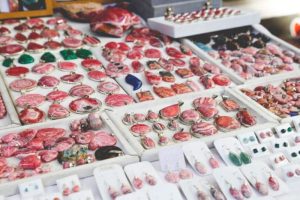
Rhodochrosite: Inca Rose
Geological reports had long noted the abundance of colorful, banded rhodochrosite at Capillitas, but failed to attract outside attention. Then in the 1930s, miners blasted into a small vug filled with rhodochrosite stalactites. Polished stalactitic cross sections, only a few inches in diameter but complex in their colors and concentric structures, soon caught the eyes of lapidaries and jewelers in Buenos Aires.
Although only available in very limited quantities, this stalactitic material focused attention on the district’s large quantities of vein material—the banded, massive rhodochrosite that for centuries had been tossed aside as worthless. Demand grew rapidly, and miners began collecting and selling pieces of the vein rhodochrosite to visiting buyers. As cabochons and carvings fashioned from this banded rhodochrosite became hugely popular, Buenos Aires jewelers coined the marketing names “rosa del Inca,” “rosinca,” and “Inca rosa,” the latter becoming the English “Inca rose.”
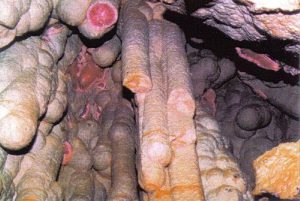
Stalactite Caves
Inca rose first attracted international attention in 1986 when miners blasted into an interconnected series of caverns, the largest 50 feet wide and 20 feet high. All were filled with stalactites and stalagmites up to five feet long and a foot in diameter, and consisting entirely of concentrically banded, pink-tored rhodochrosite.
Miners and the military officers who controlled the mines heavy-handedly collected and shipped 20 tons of these stalactites to Buenos Aires. Much more would have been shipped but military commanders, to avoid disrupting regular copper production, ordered the caves and their remaining stalactites destroyed—to the dismay of both geologists and lapidaries.
In 1987, slabbed-and-polished stalactitic Inca rose created a sensation at North American and European gem and mineral shows. The most acclaimed specimens, a foot in diameter, showed as many as 20 concentric ring structures, each the remnant of small, individual stalactites that had grown together into large, single stalactitic masses.
While copper production at Capillitas ended in 1997, miners still periodically work several of the district’s two dozen mines to extract banded Inca rose vein material for cabbing and ornamental use.
In 2002, legislators designated Inca rose as Argentina’s official national stone. Today, cabochon jewelry and carvings fashioned from Capillitas rhodochrosite are iconic souvenirs of Argentina. Popular throughout the country and abroad, they are a fitting tribute to Argentina’s Inca rose and its “rose culture.”
This story about rhodochrosite previously appeared in Rock & Gem magazine. Click here to subscribe. Story by Steve Voynick.


